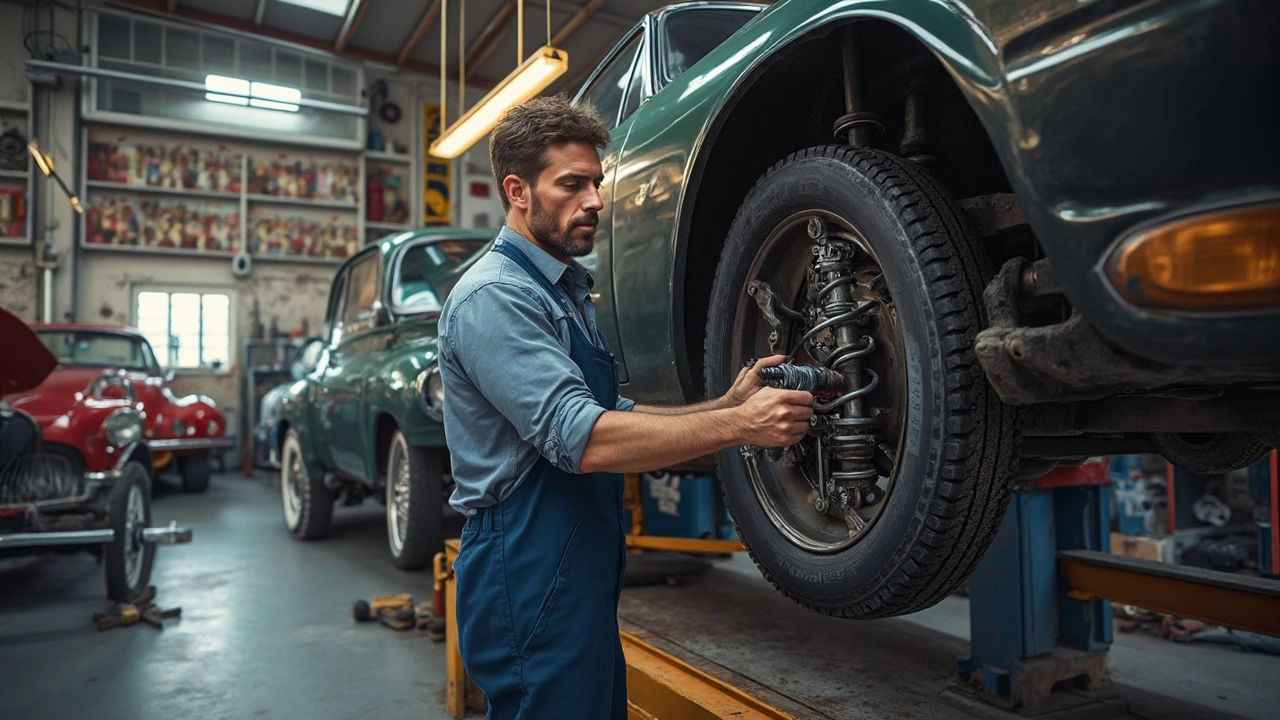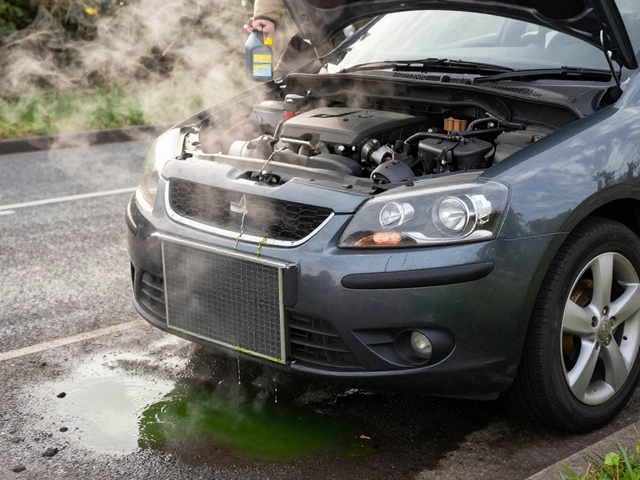Ever wondered how long your car's front suspension is supposed to last? It's not as straightforward as you might think. Generally, a typical suspension setup can last anywhere from 50,000 to 100,000 miles. But hey, that’s a pretty wide range, right? Let's be honest; it heavily depends on how and where you drive.
If you’re cruising on smooth highways most of the time, your suspension will probably stick around closer to 100,000 miles. But if you’re constantly navigating bumpy backroads or dealing with the odd speed bump (and we’ve got our fair share of those in Bristol), it might wear out faster.
The key takeaway here is that being aware of your driving conditions can help you estimate the lifespan of your suspension. Plus, paying attention to odd noises or changes in how your car handles can signal when it’s time to have things checked out. This way, you avoid more costly fixes down the road. Stay tuned for more tips on keeping everything in balance and when you might need a pro's touch!
- Understanding Front Suspension
- Factors Affecting Lifespan
- Maintenance Tips for Longevity
- Signs Your Suspension Needs Attention
- When to Call in the Experts
Understanding Front Suspension
Alright, let's dig into what makes your car's front suspension tick. The suspension system is like your vehicle's backbone, helping the wheels grip the road while keeping your ride comfy, no matter the road conditions. It's composed of various parts like shock absorbers, struts, and springs working together to take on those potholes like a pro.
Here's the deal: the main players in the front suspension system are the struts and shock absorbers. Struts are like the superstar reaching for stability and steering precision, while shock absorbers, as the name suggests, are the buffers soaking up all those bumps and vibrations. Together, they're the reason you don't feel every tiny pebble you drive over.
Now, not all cars have the same setup. Some have what's called a MacPherson strut arrangement, which combines the shock absorber and the coil spring into a single unit. This system is pretty common for the front suspension in many vehicles because it's compact yet super effective.
Let's hit you with a bit of a visual—a trusty table to give you a rundown of common front suspension types and their roles:
| Suspension Type | Key Features |
|---|---|
| MacPherson Strut | Compact, combines shock and spring, used in front suspension of many modern cars |
| Double Wishbone | Offers superior ride quality, often found in luxury and sports cars |
Understanding how these parts function can save you a lot of headaches. Recognizing early signs of wear and tear means you can nab any potential issues before they put a strain on your wallet. Keep an ear out for clunking noises or any sway in the steering—these could be telling you that your suspension needs some love.
In a nutshell, your front suspension is working as hard as you do during a busy day. Knowing what it’s up to and how it's built can make a world of difference in keeping your ride smooth and your repairs light on the pocket.
Factors Affecting Lifespan
Let’s get into what really affects how long your car’s front suspension is going to last. It's not one-size-fits-all because several factors come into play. First up, the type of roads you regularly travel on. If you're mostly on smooth highways, that’s less wear and tear compared to driving on rocky or potholed roads. City driving with constant stopping and starting can also be hard on those parts.
The quality of the suspension components themselves is another biggie. Aftermarket parts might not last as long as OEM (Original Equipment Manufacturer) parts. Those cheap deals might look tempting, but opting for high-quality materials is often wiser in the long run.
Don't forget about the weather! Harsh winter conditions or salty roads from living near the sea can cause corrosion, affecting how soon you might need to swap those parts. Keeping your car clean, especially the undercarriage, helps fight rust problems.
Lastly, let’s not overlook how much weight your car carries regularly. Hauling around heavy loads frequently? That adds extra strain, causing faster wear. Try to avoid overloading your car whenever possible to stretch the life of your suspension.
To sum up, your front suspension’s lifespan hinges on several factors like road conditions, component quality, weather exposure, and the load your vehicle handles daily. Keeping an eye on these can help you plan maintenance better and possibly save a fair bit on unnecessary repairs.

Maintenance Tips for Longevity
To squeeze the most life out of your car's front suspension, a bit of TLC can go a long way. Here's a rundown of practical tips to keep everything running smoothly and to avoid those sudden, annoying jolts during your drive.
First things first, keep an eye on your tire pressure. It's easy to overlook, but incorrect tire pressure can mess up your suspension by putting uneven strain on those parts. Make it a habit to check it every month. Most cars have a recommended pressure sticker either on the door jamb or in the owner’s manual.
Now, let’s talk about alignment. Imperfect alignment can wear out the suspension fast, especially if you're dealing with lots of uneven roads. If your car tends to drift to one side or the steering wheel vibrates, it might be time for a realignment check.
Next up, don’t ignore unusual sounds. Squeaks, clunks, or rattles are like your car’s way of saying something's not right. It could be the suspension asking for help. Address these noises sooner rather than later to avoid further complications.
Regular inspections are another smart move. Every time you go in for an oil change or routine service, have the mechanic take a quick look at the suspension components. Catching wear early can save you from bigger headaches down the line.
Keep an eye on suspension fluid levels, especially in cars with hydraulic systems. Though not as common as they once were, if your vehicle uses hydraulics, maintaining fluid levels is key to a long-lasting suspension lifespan.
Lastly, it's wise to clean your car’s undercarriage regularly. Salt and dirt can cause corrosion, eating away at those essential parts fast. A simple rinse, especially after driving through salt-treated roads, can preserve your vehicle.
- Check tire pressure monthly
- Monitor for unusual sounds
- Perform regular alignment checks
- Inspect suspension components during routine services
- Maintain suspension fluid levels when applicable
- Rinse the undercarriage frequently
By sticking to these tips, you’ll give your vehicle care a boost, ensuring that your car's front suspension remains solid for miles to come. This helps you avoid unexpected repairs and keeps those rides as smooth as possible.
Signs Your Suspension Needs Attention
Alright, let's get real about some telltale signs that your front suspension might be crying out for help. Ignoring these could lead to bigger issues, so it pays to be alert!
First up, if you feel every bump in the road like you’re driving a trampoline, your suspension's cushioning power might be fading. A well-functioning suspension shouldn't have you gripping the steering wheel for dear life every time you hit a pothole.
Listen up! Weird noises like knocking or clunking when going over bumps are shouting at you to check your suspension. Such sounds can mean worn components that need replacing pronto.
Does your car pull to one side while driving straight? That’s a classic sign your suspension is out of whack. It could be tire alignment, but it's worth having the suspension checked too.
If you notice uneven tire wear, it’s an indication something's off. Your suspension keeps tires aligned and balanced, so this might mean it’s slacking on the job.
- Worn or leaking shocks and struts
- Bouncy ride
- Unusual tire tread wear
- Drifting or pulling during turns
- Oily stains on shocks
These aren't dinner party topics, but knowing them can save you a ton of hassle and money. Keep tabs on these signs and nip any issues in the bud before they become full-blown problems. And if in doubt, get a mechanic to give it a once-over. Better safe than sorry, right?

When to Call in the Experts
So, when should you really think about calling in the pros for your front suspension? Your car might give you a few hints, and it's crucial to listen to them. Ignoring these signals can lead to more expensive fixes later on. Let’s break it down.
If you notice your car feels a bit more rollercoaster-like across bumps, it’s probably time to get an expert opinion. Also, if steering becomes a bit wobbly or you hear unusual clunking noises every time you hit a bump, those are red flags. Hold off on the DIY stuff if you see uneven tire wear—that can point directly to suspension issues.
- Strange Noises: Any clunks, thumps, or squeaks might mean something’s not right.
- Poor Handling: If your car feels like it’s swaying more than it used to, it’s a sign of potential suspension problems.
- Nose Dives: Notice your car’s nose dipping hard when you brake? It’s worth a check-up.
- Tire Wear: Patterns on your tires can reveal suspension trouble, especially if they’re uneven.
Why not handle it yourself? Sure, an oil change is doable at home, but your suspension is a bit more complex. Getting under the car safely and understanding the mechanics is best left to someone with the tools and know-how. A qualified mechanic or a trusted garage can give a detailed inspection and offer a solid solution, saving you time, stress, and possibly more money down the line.
A good tip? Keep track of when you last had your suspension checked. It’s often recommended every 15,000 to 30,000 miles, depending on your driving patterns and road conditions.
| Suspension Check Frequency | Miles |
|---|---|
| Regular Roads | 30,000 |
| Rough Roads | 15,000 - 20,000 |
Remember, keeping your ride smooth is not just about comfort. A well-maintained suspension is key to your driving safety.






